TGIFood
Through the lens and under the knife
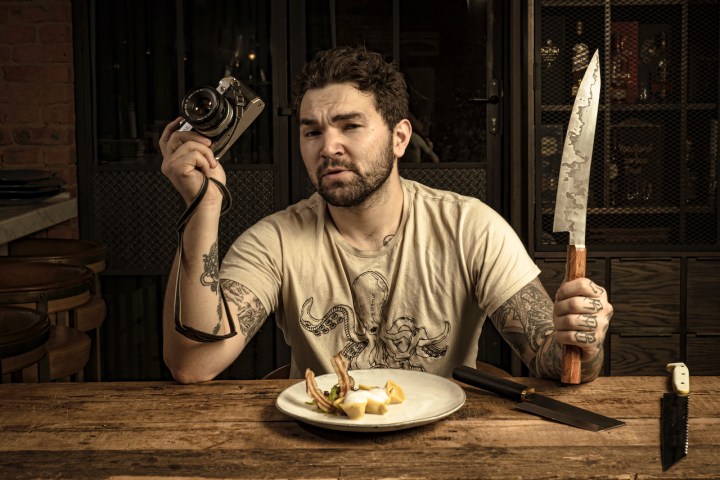
Sebastian Nico has turned two hobbies inspired by time spent in restaurant kitchens into his profession – food photography and crafting kitchen knives.
SebtheLensman. SebSteelWorks. Seb.the.Crab. Three Instagram handles. Three stories, fused by food. And kitchen magic. And flavour, fire, potency and passion.
Sabastian Nico has transformed his roots in food – if you can, imagine a restaurant kitchen as a playpen and a childhood that saw a rapid transition from cot to culinary adventures – into a lifestyle. Two hobbies that grew organically from this, food photography and playing around with welding, he has now turned into his career focus. This in line with his philosophy: “Yes, people have necessities. But sometimes you can prioritise something you love and at the same time put food on the table.”
If I might insert here: if you have passion, focus and the drive. Which it’s a no-brainer to quickly see he has, in abundance.
SebtheLensman spotlights his food photography. SebSteelWorks is where he shares pictures and descriptions of his mainly san mai process kitchen knives, san mai being the Japanese way of the knife incorporating super-hard steel, which forms the blade, sandwiched between corrosion-resistant stainless steel.
It involves a lot of power-hammering and furnace work and “50 to 100 hours per knife”, creating, crafting, refining.
And what about Seb.the.Crab? It is a playful story that he tells playfully.
“You know The Little Mermaid movie? Sebastian the crab? That’s who I was named for. If I’d been born a girl, I would have been Ariel, the mermaid.”
He has the letters CRAB tattooed between knuckles and joints on his right hand. He has many tattoos: John Lennon and his grandfather’s favourite quote, “Life is what happens when you’re busy making other plans,” is on his neck and was his first.
Peeking out from this T-shirt is Katsushika Hokusai’s Great Wave. Japanese culture is big in his life and it goes beyond the knives. Three Hieronymus Bosch tattoos are essentially tributes because, as he will tell you, similar to Japanese culture, surrealism also inspires and informs his life. “I consider Bosch, who came 300 years before Dali, the father of surrealism,” he says.
The surreal quality of many of the photo images on seb.the.crab align with this. And also with his bigger-picture commitment to art.
“I have the work of 10 different tattoo artists on my body and respect art in every way, shape and form. A chef, I think, is an artist, most definitely. I think everything has the potential to be art.”

One of these is the paring knife charcutier Richard Bosman now owns. (Photo: Sebastian Nico)
His knives have fans. “I bought two knives from Sebastian because I wanted to support local artisans making quality goods,” Cape Town charcutier Richard Bosman told me. “He posted some pictures on social media and I was drawn to a beautiful Japanese-style san mai paring knife with an olive handle and brass cuffs. I had the second knife engraved and gave it to my daughter for her birthday.
“When the knives arrived I immediately liked them but did not realise how much I would end up loving them. The blades are really sharp and retain their edge very well. The handles are ergonomic and the balance is perfect. For detailed work they are excellent. Definitely a knife to treasure for years to come.”
Several chefs have bought his knives. Not surprisingly, given his roots.
“Yes, I have purchased Sebastian’s knives,” a chef who asked to be quoted anonymously told me. “They are of excellent quality and, being the son of a chef, he understands the requirements of a blade more than most.”
Sebastian has memories of running around his chef father’s restaurant kitchen as a six-year-old. “I was brought up in a home with parents who were inspired by food that was outside the norm. My dad would drive us miles; for example, to a hole-in-the-wall in Verulam that he said served the best of something or other. We were forever trying new places.”
When he was in his teens and still in and out the kitchen, his dad, Chef Marco Nico, decided the time had come for commitment. “He wasn’t trying to get me to follow in his footsteps, but I had no clue what I wanted to do.”
From 16 to 18, Sebastian spent Friday to Sunday in the kitchen. Working. “I started on plating. Then in the grill section. Then I moved to pasta. One by one I learned to run each section.”
That did it. “While I loved to cook — still do — and did consider hotel school, by the end I knew I didn’t want to work in a kitchen.”
He had, along the way, taken up photography as a hobby and done some welding.
He decided to go travelling for a while. Worked in France managing chalets. Spent time getting to know family in Italy.
Then came back to Durban and decided to take photography seriously, food photography being a natural focus. His route was to intern. To work with the best. To learn on the job.
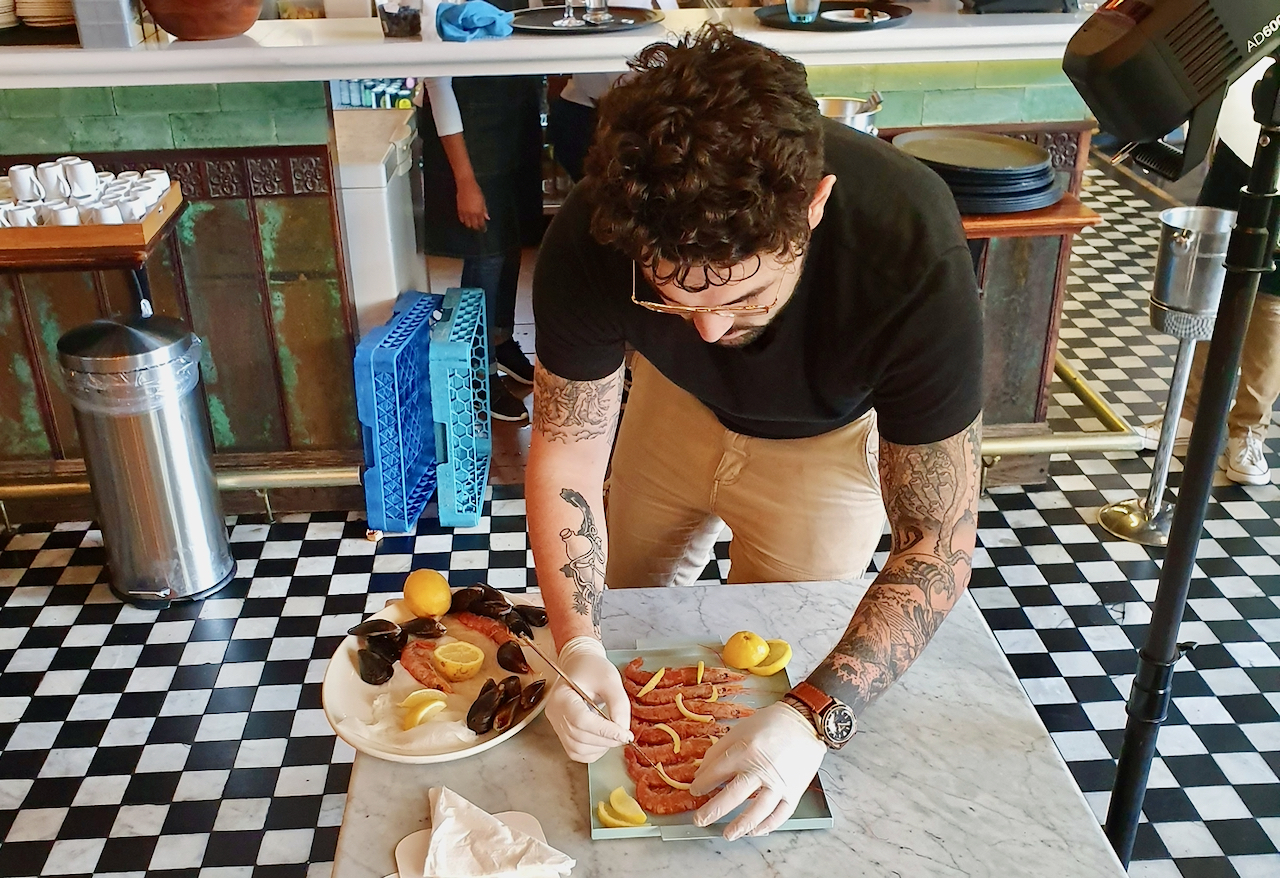
Sebastian Nico plates up for a food shoot at Chef’s Table. (Photo: Joshua Jordan)
So, let’s face it, in the age of the smartphones we are all photographers.
The decline in luscious restaurant food pics shared on social media during lockdown has, for reasons I don’t need to spell out, been marked. This may change again. Who knows?
Meanwhile, is it just because I follow the Locked Down Cookbook Facebook group we wrote about on TGIFood early in lockdown, or have pictures of meals cooked at home become the new trend? So how about giving some tips for amateur food photographers, I ask Sebastian?
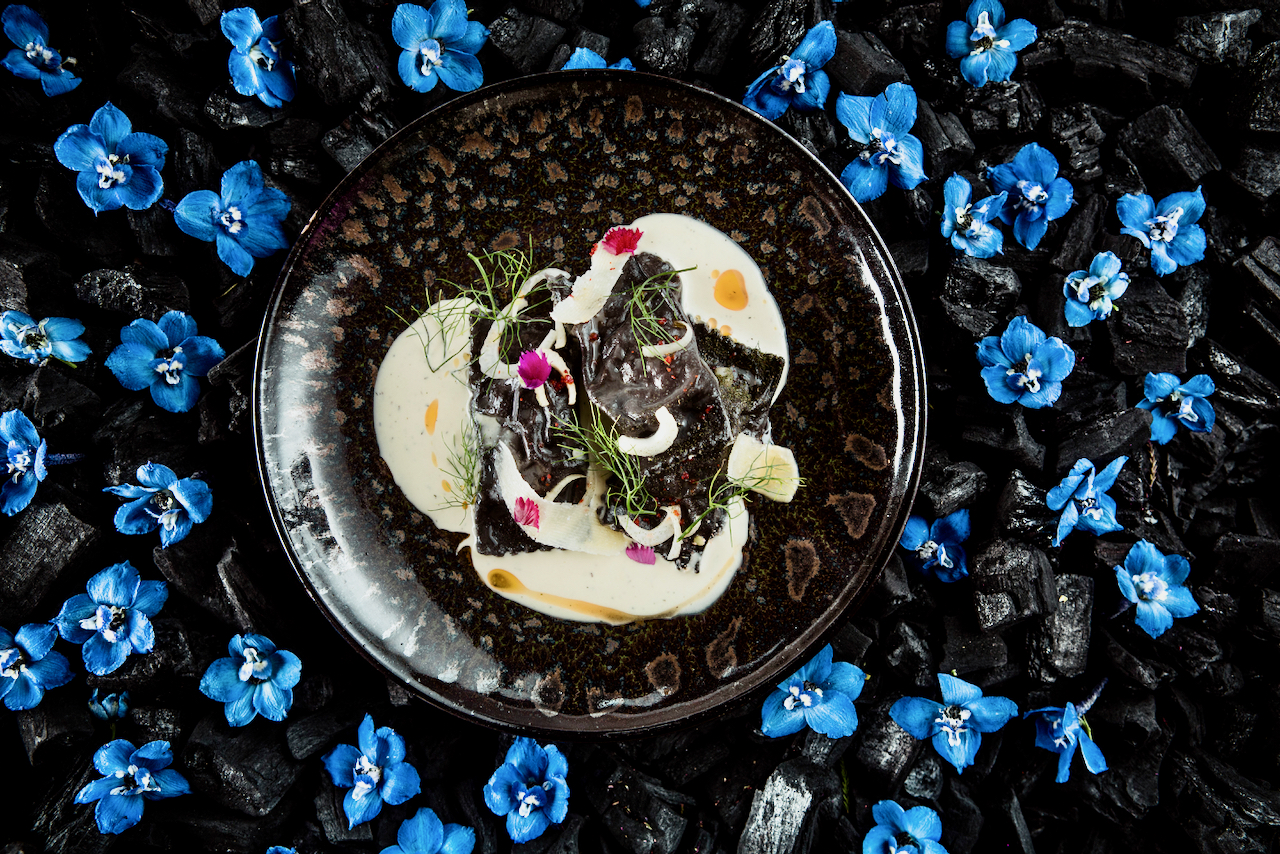
Sebastian Nico gets artistic for us with langoustine agnolotti on a Chef’s Table shoot. (Photo: Sebastian Nico)
- Choose good looking subject matter. To this end, think of the plate, think of lighting and think of focus, given that you can’t make much more of the image than what you set up.
- Either let the dish speak for itself or give it a background. Texture is good. An old table for example, with layers of paint, for a rustic feel. Simple marble for a “high-end” dish. Choose a background or backdrop to complement what you’re trying to say, the mood you’re trying to convey. Be sure to coordinate the surroundings to your dish, not your dish to your surroundings.
- Light can make or break a shot when using natural light. Look for a window offering a single light source. Use a piece of white paper to bounce back light to add mood, reduce shadows, create depth.
- Consider your angle. “Top down is my favourite. It turns the dish into a painting, in a way.” Otherwise, a 35 to 40 degree angle on the food with ideally some background blur.
- Consider, too, the colour combinations. Orange steamed crab on teal or aqua, for example. “Use complementary colours. Use a colour wheel for guidance.”
- A stylist would do the plating for a professional shoot. Doing it yourself, make sure the quantities and placement are balanced. Pork belly with apple mash, for example: pay attention to the ratios. Use the plate like a frame. We know humans are attracted to the golden ratio and the rule of thirds. Read about them. Use them as guidelines.
And visit his website for more inspiration.
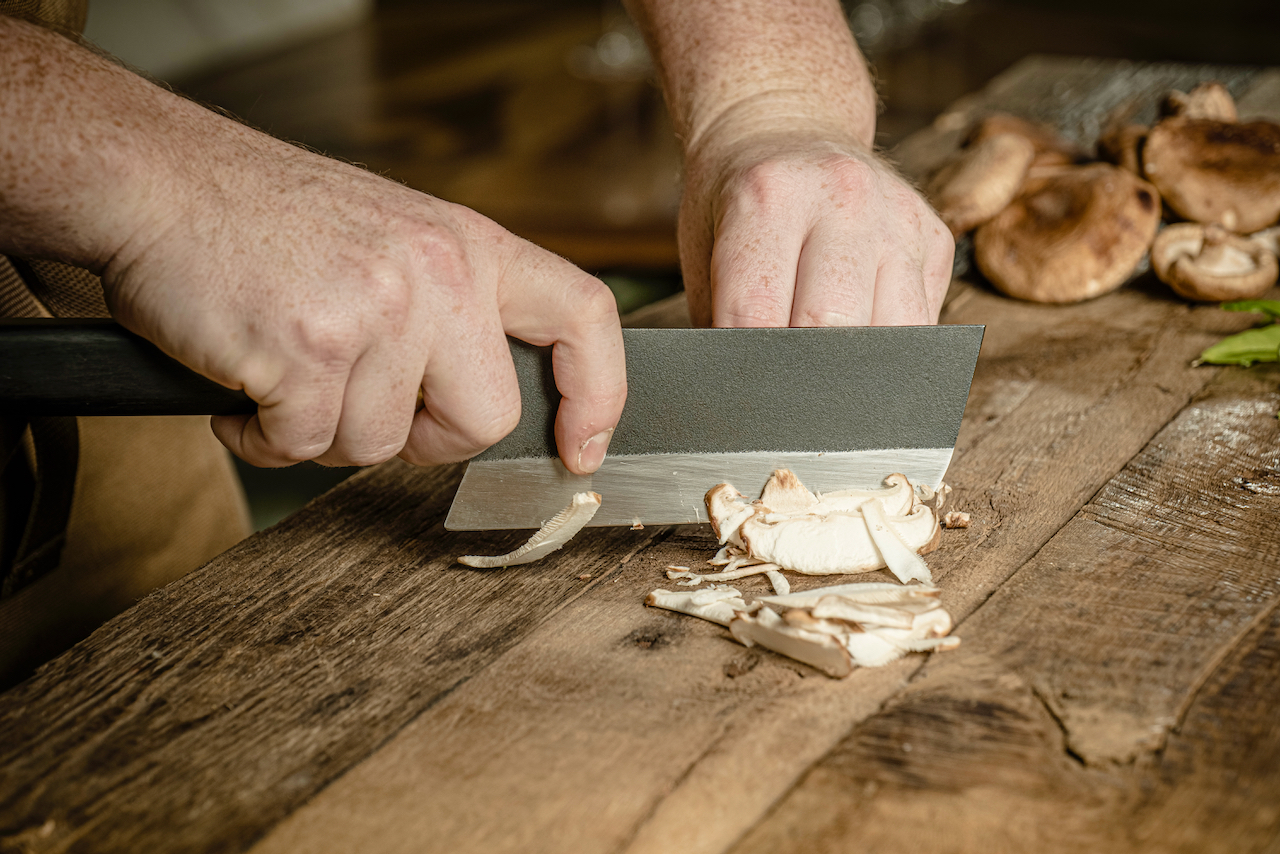
Chef’s Table head chef Mathew Armbruster cuts mushrooms with a sebsteelworks nakiri, perfect for chopping veggies. (Photo: Sebastian Nico)
It was on days that Sebastian didn’t have photo shoots that he began taking his knife-making hobby more seriously. “I bought myself a high-quality bulk grinder. I already had a furnace.” And during lockdown he has taken his artistry to new levels.
“There are many variables to a good knife,” he says. “So many things to consider. The science. The blade geometry. The ergonomics.”
There is wisdom that comes from experience. From the in-the-body act of “doing”. “Nothing beats learning hands-on from someone who knows,” he says. He requests that I give credit to his mentor, De Wet van Zyl, proprietor at Dark Wing Blades, where he makes his knives these days.
Handmade kitchen knives are costly. Perhaps between R2,500 and R5,000.
“A handmade – anything – requires time and effort,” muses Sebastian, when I ask why someone might invest in such a knife compared to what I hack away with in my kitchen.
“It’s not only beautiful but when you buy it, you have a piece of someone’s soul.” When he finishes a knife, he will keep it for a few days to appreciate it before offering it, often on Instagram or Facebook, for sale.
A chef, typically, will have a set of knives and use them every day.
A home cook might just have one special knife. Perhaps use it a lot less.
“I see cooking as a form of meditation,” he says, poetically. “Something you do at the end of the day. Preparing the meal you will consume. The resting period between what has been and what is to come.”
Nice.
And I have seen the pleasure the surge of interest in cooking at home during lockdown has given friends who have experimented in the kitchen for the first time, or with more commitment and enthusiasm than before.
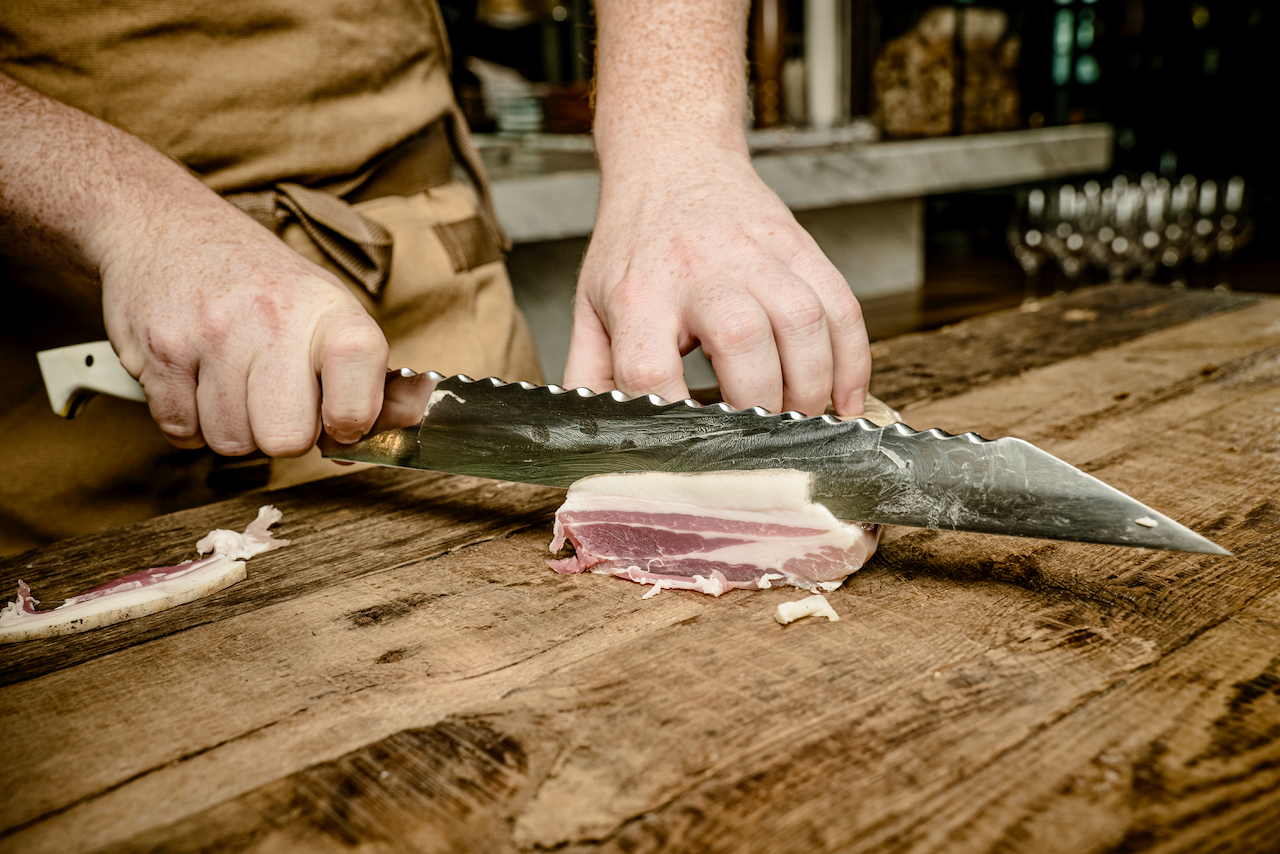
Chef Mathew Armbruster test-runs a sujihiki, ideal for carving meat. (Photo: Sebastian Nico)
Then there is the cutting edge. “Be careful,” he says, when I pick up the knives he’s brought to show me. Ask about the handles. The shapes.
He picks up what is a sujihiki, a carving knife, one which happens to be the biggest knife he has made to date. He runs it along his forearm. Good grief. Suddenly there appears on the table between us a small pile of body hair. Shaved, cut-throat razor style, just like that, from his forearm.
“A good knife, you should never have to press down on to cut something,” he says.
I test my chef’s knife back home. Even after running it up and down on the wand-like metal knife sharpener that hangs in my kitchen, I realise I could keep running it up and down my forearm till next week and every hair will remain intact. And when I slice a tomato I see that not only do I need to press down, I also have to pierce the tomato skin with the tip to get the slice started.

This sujihiki, different style, is the biggest knife Sebastian Nico has made to date. (Photo: Sebastian Nico)
Googling “kitchen knives” for this piece was a fascinating exercise. I advise any reader who hasn’t thought too much about their kitchen slicing habits to give it a go. You might start with this Wikipedia Japanese Kitchen Knife link as a good overview. It includes info on the gyuto, or regular chef’s knife, which unless you’re a chef or wanting a collection, is a good go-to standard.
I found myself back in 14th century Japan reading links on samurai and sword manufacturing. Not essential kitchen knife reading, but interesting.
To choose a good kitchen knife, says Sebastian, note the steel being used. “Many are made out of 420 stainless steel. These you might want to avoid as your knife needs a decent amount of hardness.” Here is a link that is an explanatory guide to good steel.
On the commercial front, Wüsthof knives, from Germany, are usually good quality entry level, says Sebastian. Or perhaps see this Wired magazine overview of best chef’s knives, up-to-date as written during Covid.
“Then you want to look at the shape. At the bolster, which is a wide bit (like a skirt bolster) where the blade meets the handle. You want a knife without a full bolster because you can’t sharpen that part and so the wearing will be uneven.
“And you want a good contact area, so you need to be aware of your cutting or chopping style. If the knife blade is curved and this is not how you want to use the knife, it could cause you difficulties.”
The thickness behind the knife edge and at the handle can make the knife difficult to sharpen.
And he shows me how to pinch-grip, with thumb and forefinger, for better knife control. This to replace the pointed finger style I learned years ago in woodwork classes, advised by the woodwork teacher to use not only when sawing wood but also for bread and veggie slicing. See this link for knife grip styles.
Oh, and don’t partake of my trick of trying to sharpen a mediocre blunt knife by means of your own mediocre blunt knife-sharpening implement.
“Take your knife to a professional when it needs sharpening,” the inspiring 23-year-old alternative culinary talent advises me. “It’s only going to cost you about R40.” Well I never. DM/TGIFood
Wanda Hennig is a food and travel writer based in Durban. She has worked on newspapers and magazines in South Africa and the San Francisco Bay Area and freelanced extensively. She is author of Cravings: A Zen-inspired memoir…. Reach her via her website wandahennig.com





 Become an Insider
Become an Insider
Comments - Please login in order to comment.